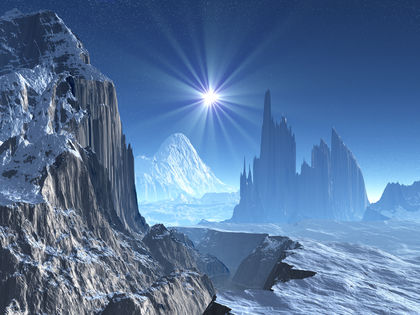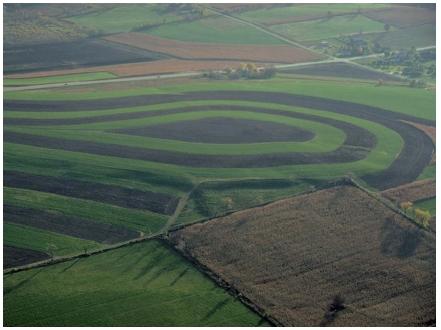Ice ages

Ice ages were periods in Earth's history when glaciers and vast ice sheets covered large portions of Earth's surface. Earth's average annual temperature varies constantly from year to year, from decade to decade, and from century to century. During some periods, that average annual temperature has dropped low enough to allow fields of ice to grow and cover large regions of Earth.
The most recent ice age
Over the last 2.5 million years, about two dozen ice ages have occurred. That means that Earth's average annual temperature greatly shifted upwards and downwards about two dozen times during that time. In each case, a period of significant cooling was followed by a period of significant warming—called an interglacial period—after which cooling took place once more.
Scientists know a great deal about the cycle of cooling and warming that has taken place on Earth over the last 125,000 years, the period of the last ice age cycle. They have been able to specify the centuries and decades during which ice sheets began to expand and diminish. For example, the most severe temperatures during the last ice age were recorded about 50,000 years ago. Temperatures then warmed before plunging again about 18,000 years ago.
Clear historical records are available for one of the most severe recent cooling periods, a period now known as the Little Ice Age. This period ran from about the fifteenth to the nineteenth century and caused widespread crop failure and loss of human life throughout Europe. Since the end of the Little Ice Age, temperatures have continued to move up and down. No one is quite certain whether the last ice age has ended or whether we are still living in it.
Evidence for the ice ages
A great deal of what scientists know about the ice ages they have learned from the study of mountain glaciers. When a glacier moves downward out of its mountain source, it carves out a distinctive shape on the surrounding land. The "footprints" left by ice-age glaciers are comparable to those formed by mountain glaciers.
Ice Age Refuges
The series of ice ages that occurred between 10,000 and 2,500,000 years ago had a dramatic effect on the climate and life-forms in the tropics. During each glacial period, the tropics became both cooler and drier, turning some areas of tropical rain forest into dry seasonal forest or savanna. However, some areas of forest escaped the dry periods and acted as refuges (protective shelters) for forest plants and animals. During subsequent interglacials, when humid conditions returned to the tropics, the forests expanded and were repopulated by plants and animals from the species-rich refuges.
Ice age refuges correspond to present-day areas of tropical forest that typically receive much rainfall and often contain unusually large numbers of species. The location and extent of the forest refuges have been mapped in both Africa and South America. In the African rain forests, there are three main centers located in Upper Guinea, Cameroon and Gabon, and the eastern rim of the Zaire basin. In the Amazon Basin, more than 20 refuges have been identified for different groups of animals and plants in Peru, Colombia, Venezuela, and Brazil.
The transport of materials from one part of Earth's surface to another part is also evidence for ice ages. Rocks and fossils normally found only in one region of Earth may be picked up and moved by ice sheets and deposited elsewhere. Also, moving ice may actually leave scratches on the rock over which it moves, providing further evidence for changes that took place during an ice age.
Causes of the ice ages
Although scientists do not know exactly what causes ice ages or periods of glaciation, they have offered many theories. These theories point to either astronomical (space-based) factors or terrestrial (Earthbased) factors.
Astronomical factors. One of the most obvious astronomical factors is the appearance of sunspots. Sunspots are eruptions that occur on the Sun's surface during which unusually large amounts of solar energy are released. The number of sunspots that occur each year changes according to a fairly regular pattern, reaching a maximum about every 11 years. Some scientists have suggested that the increasing and decreasing amounts of energy sent out during sunspot activity may contribute in some way to the increase and decrease of ice fields on Earth's surface.
Other scientists have pointed to the changes in the geometry of Earth's orbit around the Sun as factors that have led to ice ages. Those

changes have resulted in Earth receiving more or less solar radiation, becoming consequently warmer or cooler. In the 1930s, Serbian mathematician Milutin Milankovitch (1879–1958) proposed a theory to explain such changes. The Milankovitch theory states that three periodic changes in Earth's orbit around the Sun affect the amount of sunlight reaching Earth at different latitudes, leading to ice ages. First, Earth's axis wobbles like a gyroscope, tracing a complete circle every 23,000 years or so. Second, while wobbling, the axis tilts between 22 and 24.5 degrees every 41,000 years. Third, Earth's elliptical orbit pulses, moving outward or inward every 100,000 and 433,000 years.
Terrestrial factors. Changes that take place on Earth itself may also have contributed to the evolution of ice ages. For example, volcanic eruptions can contribute to significant temperature variations. Dust particles thrown into the air during an eruption can reflect sunlight back into space, reducing heat that would otherwise have reached Earth's surface.
A similar factor affecting Earth's annual average temperature might be the impact of meteorites on Earth's surface. If very large meteorites had struck Earth at times in the past, such collisions would have released huge volumes of dust into the atmosphere. The presence of this dust could have also reduced Earth's annual average temperature for an extended period of time.
Whatever the cause of ice ages, it is clear that they can develop as the result of relatively small changes in Earth's average annual temperature. It appears that annual variations of only a few degrees can result in the formation of extensive ice sheets that cover thousands of square miles of Earth's surface.
[ See also Geologic time ]